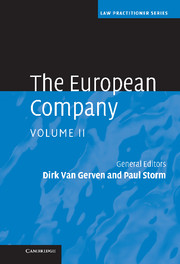The SE in its sixth year: some early impressions
from Part I
Published online by Cambridge University Press: 06 July 2010
Summary
Implementation by Member States
On 8 October 2007 it will be six years since the Statute for a European Company was adopted. It is early days yet to come up with an assessment, but certain trends are already taking shape. First, however, it is worth looking at the implementation at national level of the relevant Community instruments. Although a regulation is directly applicable throughout the EC and need – indeed must -not be transposed into national law, Council Regulation of 8 October 2001 on the Statute for a European Company (SE) (the ‘Regulation’ or ‘Reg.’) leaves so many options to the Member States that it was necessary for the latter to enact their own laws to enable SEs to be registered in their territories. In addition, Article 64 Reg. imposes certain obligations on Member States to create legislation with respect to SEs. As to Council Directive of 8 October 2001 supplementing the Statute for a European company with regard to the involvement of employees (the ‘Directive’ or ‘Dir.’), this – of course – had to be transposed by each Member State. Due to the extremely convoluted wording of this directive, this turned out to be a very difficult and time-consuming job. Consequently, only eight of the (then) 25 EU Member States and one of the additional three EEA Member States managed to meet the deadline for transposition: 8 October 2004.
- Type
- Chapter
- Information
- The European Company , pp. 3 - 14Publisher: Cambridge University PressPrint publication year: 2008

